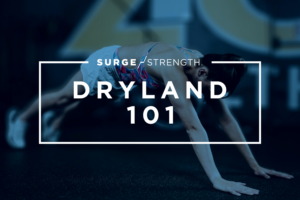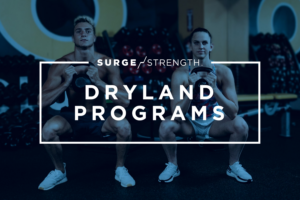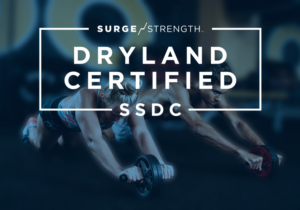Compared to 5, 10, or 20 years ago, the swimming world has undergone a large cultural shift in how we see dryland; we’ve seen less conversations about whether or not a team should incorporate dryland at all, and instead have seen it replaced with many more conversations about how to command better dryland training. This is for a simple reason: dryland brings previously untapped success, and everyone loves a success story.
Perhaps, the greatest joy of being a coach is in helping athletes transform and reach their highest potential – in working together to create your own success story. The same goes for the swim-lovers who are behind SURGE Strength (us!). We have been in the dryland trenches with swim coaches and swimmers for over a decade, and therefore have quite a few of our own success stories to tell. We hope that you benefit from our stories and can apply them to your own swim coaching scenarios.
Better Dryland Training Story #1 – Train Smarter Not Harder
Cullen Jones is one of the best sprint freestylers in the world. However, at one point in time he was the underdog. Leading up to the Beijing Olympics in 2008, some people were surprised to see him earn his spot on the infamous 4×100 relay with Michael Phelps. Founder of SURGE Strength, Chris Ritter, had the privilege of training Jones as he prepared for the 2008 Olympics. Reflecting on his experience training and talking with Jones, Chris emphasizes that the secret to Cullen Jones success was the optimal combination of dryland and swimming paired together.
Jones’ training protocol shows that strength training is the missing link that can take elite swimmers from being very good, to being the best of all time. Chris mentions that Jones lifted heavy weights and focused on improving his overall athleticism through dryland. This is very different than haphazardly completing some abs and stretching on the pool deck. And, we’ve seen the same concept work for swimmers of all ages and abilities. Better athletes are faster swimmers.
From Cullen, we can learn these takeaways: When implementing a dryland program, focus on building strength rather than conditioning your athletes aerobically. Furthermore, focus on periodizing each dryland session into distinct training phases throughout your swim season. Periodization maximizes recovery as well as training potential.
Better Dryland Training Story #2 – Shoulder Care
In addition to basic strength training, SURGE Strength also firmly believes in the benefit of incorporating injury prevention exercises, better known as “pre-hab.” Putting pre-hab in dryland is one of the best time investments coaches can make. The more you can strengthen key areas, like the muscles around the shoulder joint, the less likely your swimmers will be forced to kick through practice or take significant time out of the water. In turn, pool time remains consistent, and swimmers stay healthy through long seasons of intense training. Chris unpacks the value of shoulder pre-hab in the video below.
Better Dryland Training Story #3 – Dryland is for Everyone
Speaking of underdogs, chances are that you have some underdogs on your team as well. These are the athletes who love the sport but are not necessarily training up to their potential… yet. The thing about underdogs is that they are defined by two elements: a challenge and a will to overcome. From that definition, everyone can be an underdog. Underdogs are NOT defined by what age group they come from (and in fact, some of our best underdog stories come from some of the master’s swimmers and triathletes that we have worked with).
If you see a swimmer banging their head against a wall of sorts with no solution in sight, there is almost always a new way to try things on the dryland side. And, if you can get a swimmer to make a breakthrough on land in their training, the likelihood they persevere and overcome that challenge while in the water is much higher. Therefore, one of our core values is that dryland is for EVERYONE, because we really have seen it affect so many people in so many different (positive) ways. Dryland is the underdog’s gold no matter the age.
Better Dryland Training Story #4 – Sprints and Distance Swimmers Benefit
Dryland builds athleticism in children that carries over into other sports. For older athletes, dryland improves stability and balance. In addition, it decreases the likelihood of developing diseases such as osteoporosis. For athletes in the middle of their swimming career, dryland is the missing link that takes their performance to the next level and eliminates burnout. Whether you are a sprinter or distance swimmer, science shows that dryland yields better results in the water. Below is a story of how Chris inspired a group of high school swimmers with early-morning dryland workouts. He specifically notes the power that dryland had on both their confidence and performance in the sport of swimming. Dryland ultimately made the difference between some athletes choosing to swim in college and ending their swim career with high school.
Better Dryland Training Story #5 – Make a Plan
The truth is that most swimmers eventually hit a plateau or injure themselves when there is no proper dryland program in place. Specifically, swimmers at the high school and collegiate level find themselves hitting a wall with their times if they don’t have the athleticism and strength on land to match their ability in the water. In this success story, Chris talks about helping swimmers at the division III level hit best times mid-season. As a result, the athletes increased their distance per stroke as well as their strength gains on land. Dryland doesn’t have to be overwhelming. It should be motivating, helpful, and fun.
Time and time again, we see a distinct change in our athletes after they incorporate a consistent dryland program, both in the water and on land. Yet, some coaches still steer clear of dryland. Others have a dryland plan that completely contradicts their goals in the water. Therefore, these coaches either don’t know how to coach dryland properly. Otherwise, they don’t understand the impact it has on their athletes. We encourage you to learn from our stories. Instead of winging it, make a plan.
We encourage coaches who don’t understand the value of better dryland training or feel under-qualified to coach dryland to get educated or to reach out to learn more. SURGE Strength is here to help you establish a plan that compliments your swim program instead of competing with it. Once you start to see the role that dryland has in a thriving swim program, you will generate some pretty awesome success stories, too.
MORE DRYLAND RESOURCES FROM SURGE STRENGTH:
ENROLL IN A DRYLAND 101 COURSE FOR FREE
GET STARTED WITH A DRYLAND PROGRAM
LEARN ABOUT BECOMING SSDC

SURGE Strength’s Mission:
BUILD BETTER ATHLETES
GENERATE FASTER SWIMMERS
Courtesy of SwimSwam’s exclusive dryland training partner, SURGE Strength.
SURGE Strength is swim-specific, strength training by Chris Ritter. SURGE Strength builds better athletes and faster swimmers through Dryland Programs, Courses and Certification.











